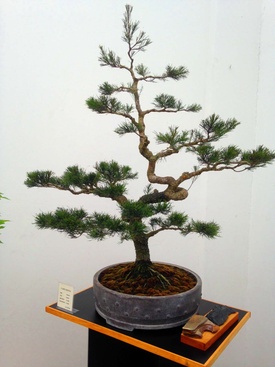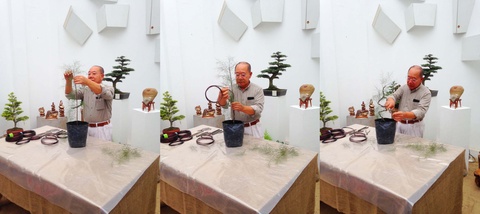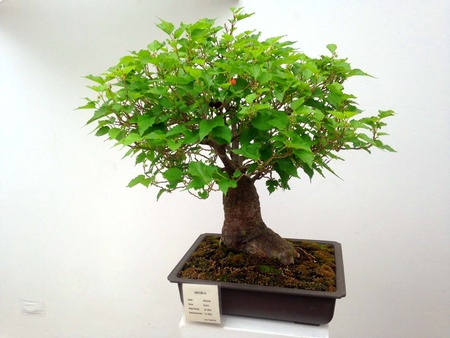“A bonsai is an artistic replica of a miniature tree.” The definition is not in a gardening or Japanese culture book, but in the novel “Bonsai”, by the Chilean writer Alejandro Zambra, a story of love and obsession with writing, which was also his first foray into the narrative of this young writer. .
Luis Takehara's love story for bonsai began 18 years ago. It was the nineties and Peru's economy was not one of the best. Luis's fishing business was going through difficulties (among them, the El Niño phenomenon, which warms the waters of the Pacific Ocean causing the schools to disappear) so he decided to dedicate himself more ardently to a hobby cultivated in childhood.
“Since I was a child I liked bonsai, my dad grew them so I decided to dedicate more time to them,” says Luis, who started with ficus and myrtle, at a time when there were no books from which to learn the correct technique. “It's like a vice,” he says now that he is surrounded by some of his oldest bonsai trees, more than 20 years old, in the Plantique store, a boutique specialized in gardening and decoration with plants.
In their home in Cieneguilla, Luis and his wife take care of some 20,000 plants of more than 400 varieties that he grows in what has become the business that led him to set foot on land and leave the fish in peace. Exhibitions, bonsai sales and workshops are part of the routine of this lover of the great art of small trees that has attracted the attention of many in Peru. Now, let's listen to a class from the teacher.
Lesson 1: Any tree can be a bonsai
For more than one this is a surprise. There are no dwarf trees by nature. They are not brought from distant Japan, nor are they rare species that are found by explorers who treasure them for their great value. Any tree, any tree, can be turned into a bonsai using a technique that is taught to adults and children in Peru.
The Lima Art Museum (MALI), for example, offers a workshop for children ages 15 and up, which seeks to “develop creativity to grow and conserve plants,” in addition to imparting knowledge about techniques for bonsai creation. The reason for its size has a fairly simple answer: so that it fulfills an ornamental purpose.
“30% of the top of the tree is cut to prevent it from continuing to grow,” says Luis Takehara to the students who take notes and photographs in Plantique, where there are some of his bonsai, from the youngest ones that he bought in nurseries and that used for demonstration, even casuarinas that have come of age and can cost up to three thousand dollars.
Lesson 2: Bonsai comes from China
This is said by Master Takehara and those who have studied the history of this technique. According to the Peruvian Bonsai Club, its origin dates back about a thousand years and is related to Taoism. “This religion had the belief that bonsai concentrated the forces of nature due to its small size.” The cult of nature has always been a sensory and spiritual stimulus.
It is believed that the first bonsai appeared naturally. They were “trees dwarfed by the inclemency of the environment. “They were found on the steep slopes of the mountains and were very difficult to find, if not impossible to rescue.” But since its cultivation as an art, various ways have appeared to make an ordinary plant age without growing.
“In China they put stones as weights and held them with straps and pulleys,” Takehara tells us. Now some use aluminum threads or wires. The teacher does not recommend copper ones because they are difficult to twist, and what is sought is for it to surround the trunk and some branches to give it pronounced curves and different shapes. “After two months you have to remove the wire to prevent it from becoming embedded in the trunk when it grows,” he points out.
Lesson 3: The bonsai is also the vessel
The translation of bonsai is usually understood as “planted in a pot” ('bon', tray or vessel, 'sai', tree or plant). Every bonsai consists of two parts: the living tree and the container that contains it. That is why workshops are held for this second element, such as the cold porcelain workshop held at the Peruvian-Japanese Association, in order to achieve aesthetic and natural harmony for the plant.
In Plantique, Luis Takehara's bonsai arrived accompanied by Claudio Balducci's stone creations and various vessels or supports (wooden, ceramic pots, bases of cut trunks, pedestals, pots and others) that make bonsai a major art. . Its proper choice is important as it will help control the growth of the plant.
“The bonsai does not need a lot of water because we do not want it to continue growing. The land is changed every year, it is not fertilized,” explains teacher Takehara. “If the plant were in a garden, its growth would be faster than in a pot,” he says, adding that for hobbyists it is ideal to start with a young plant with small leaves (a casuarina, a ficus or a lemon cypress), otherwise more than two years.
Lesson 4: Bonsai is patience
Before a young and amazed audience, Luis Takehara twists the plant with the help of the wire, prunes many branches and, in a moment that generates suspense, accidentally breaks the main trunk. "If we have a quarter of the diameter of the trunk left that has not broken, there is no reason to be scared, the plant will seal." The teacher constantly receives former students or clients who come to tell him about diseases or other bonsai problems.
“It takes a lot of patience,” says Luis with the serene voice of someone who spends his days among plants. “When I deliver a bonsai I tell them that I hope they call me and visit me after many years to tell me that the tree is still alive.” One of the most appreciated characteristics of this art is its longevity, which can be seen in the aging of the bark that makes it look like a life-size tree.
In Washington, The National Bonsai & Penjing Museum has a 390-year-old white pine bonsai that survived the atomic bomb that fell on Hiroshima on August 6, 1945. Bonsai is also history because its silhouette reflects its own life, and because each plant brings back memories with its slow maturation.
Lesson 5: Bonsai is a living art
Bonsai is a living art because the tree continues to grow and change due to age or according to the seasons and climate (in spring and summer they grow faster). Seeing it bloom is a phenomenon of nature that artificial plants cannot compete against.
Bonsai is a living art because in Peru and other parts of the world the community of those who love these small trees grows like branches. Here, the Peruvian Bonsai Club imports seeds to have bonsais originating from Japan, such as the Japanese white pine or the red maple, while master Takehara has visited Piura, Trujillo, Chiclayo and Arequipa offering demonstration workshops.
Bonsai is a living and endless art, because each tree is unrepeatable and because the varieties are infinite. Plus, your care never ends. You only need a seed or a cutting (piece of a branch or trunk of a tree) which costs just one dollar in Lima. Great art at a low price.
© 2015 Javier García Wong-Kit









